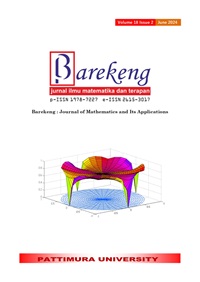VALUE AT RISK ESTIMATION USING EXTREME VALUE THEORY APPROACH IN INDONESIA STOCK EXCHANGE
Abstract
Extreme Value Theory (EVT) is a method used to identify extreme cases in heavy tail data such as financial time series data. This research aimed to obtain an estimate of stock risk through the EVT approach and compare the accuracy of the two EVT approaches, Block Maxima (BM) and Peaks Over Threshold (POT). The method used to estimate stock risk is VaR with the BM and POT approaches, and the Z statistic is used to compare the accuracy. The data used, and the limitation in this research is daily closing price data for non-cyclical consumer stocks included in LQ45 for the period February 01, 2017, to January 31, 2023. Other research limitations are using weekly blocks or 5 working days in dividing BM blocks, using the percentage method in determining threshold values in the POT approach, and using Maximum Likelihood Estimation (MLE) to estimate EVT parameter estimates. The results of the VaR analysis show that the risk level generated by the POT method is greater than the risk level from BM. The results of backtesting between the two EVT approaches in estimating VaR values show that the POT approach is more accurate than the BM approach.
Downloads
References
S. Baek, S. K. Mohanty, and M. Glambosky, “COVID-19 and stock market volatility: An industry level analysis,” Financ Res Lett, vol. 37, p. 101748, 2020.
M. Siahaan and T. L. Rasmara, “Pengaruh Kinerja Keuangan dan Risiko Terhadap Return Saham Pada Perusahaan Goods Industry yang Terdaftar di Bursa Efek Indonesia Periode 2016-2019,” GOODWILL, vol. 3, no. 1 Juni, pp. 311–320, 2021.
M. Mulyadi, N. Ustadi, D. Rimbano, M. Martini, and H. A. Djohan, “Analisis Kinerja Saham Lq45 Sebelum Dan Selama Pandemi Coronavirus Disease (Covid-19) Di Indonesia,” Jurnal Interprof, vol. 6, no. 2, pp. 156–167, 2020.
A. Burchi and D. Martelli, Measuring Market Risk in the Light of Basel III: New Evidence From Frontier Markets. Academic Press, 2016. doi: https://doi.org/10.1016/B978-0-12-809200-2.00007-5.
B. Figuet, R. Monstein, M. Waltert, and J. Morio, “Data-driven mid-air collision risk modelling using extreme-value theory,” Aerosp Sci Technol, vol. 142, p. 108646, 2023, doi: https://doi.org/10.1016/j.ast.2023.108646.
S. and K. G. G. Aslanertik B. Esra and Erdem, “Extreme Value Theory in Finance: A Way to Forecast Unexpected Circumstances,” in Risk Management, Strategic Thinking and Leadership in the Financial Services Industry : A Proactive Approach to Strategic Thinking, Ü. Dinçer Hasan and Hacioğlu, Ed., Cham: Springer International Publishing, 2017, pp. 177–190. doi: 10.1007/978-3-319-47172-3_12.
A. J. McNeil, “Extreme value theory for risk managers,” Departement Mathematik ETH Zentrum, vol. 12, no. 5, pp. 217–237, 1999.
J. Franke, W. K. Härdle, and C. M. Hafner, Statistics of Financial Markets an Introduction 5th Edition. Springer, 2018.
N. A. Dinaryanti and S. Darwis, “Estimasi Parameter Distribusi Generalized Extreme Value (GEV) dengan Maximum Likelihood Estimation (MLE) dan L-Moments pada Data Vibrasi Akselerasi Bearing,” Prosiding Statistika, vol. 7, no. 1, pp. 113–120, 2021.
A. Ferreira and L. De Haan, “On the block maxima method in extreme value theory: PWM estimators,” The Annals of statistics, pp. 276–298, 2015.
D. Cooley, P. Naveau, V. Jomelli, A. Rabatel, and D. Grancher, “A Bayesian hierarchical extreme value model for lichenometry,” Environmetrics: The official journal of the International Environmetrics Society, vol. 17, no. 6, pp. 555–574, 2006.
S. Coles, J. Bawa, L. Trenner, and P. Dorazio, An introduction to statistical modeling of extreme values, vol. 208. Springer, 2001.
S. W. R. Mida, H. Perdana, and others, “Estimasi Value at Risk Dalam Investasi Portofolio Saham Menggunakan Metode Peak Over Threshold,” Bimaster: Buletin Ilmiah Matematika, Statistika dan Terapannya, vol. 9, no. 3, 2020.
M. F. Muda, M. Kleden, and K. B. Ginting, “Estimasi Parameter Distribusi Pareto,” Jurnal Diferensial, vol. 2, no. 1, pp. 1–7, 2020.
I. S. Prayoga and A. Ahdika, “Pemodelan Kerugian Bencana Banjir Akibat Curah Hujan Ekstrem Menggunakan EVT dan Copula,” Jurnal Aplikasi Statistika & Komputasi Statistik, vol. 13, no. 1, pp. 35–46, 2021.
A. Ambarsari, S. Sudarno, and T. Tarno, “Perbandingan Pendekatan Generalized Extreme Value dan Generalized Pareto Distribution untuk Perhitungan Value at Risk pada Portofolio Saham,” Jurnal Gaussian, vol. 5, no. 3, pp. 361–371, 2016.
S. D. Campbell, “A review of backtesting and backtesting procedures,” 2005.
Y. Rahmita, “Analisis validitas VaR dalam pengukuran risiko nilai tukar terkait arahan implementasi stressed VaR pada revisi Basel II,” Universitas Indonesia, Jakarta, 2012.
Copyright (c) 2024 Fadhila Febriyanti Najamuddin, Erna Tri Herdiani, Andi Kresna Jaya

This work is licensed under a Creative Commons Attribution-ShareAlike 4.0 International License.
Authors who publish with this Journal agree to the following terms:
- Author retain copyright and grant the journal right of first publication with the work simultaneously licensed under a creative commons attribution license that allow others to share the work within an acknowledgement of the work’s authorship and initial publication of this journal.
- Authors are able to enter into separate, additional contractual arrangement for the non-exclusive distribution of the journal’s published version of the work (e.g. acknowledgement of its initial publication in this journal).
- Authors are permitted and encouraged to post their work online (e.g. in institutional repositories or on their websites) prior to and during the submission process, as it can lead to productive exchanges, as well as earlier and greater citation of published works.






1.gif)



